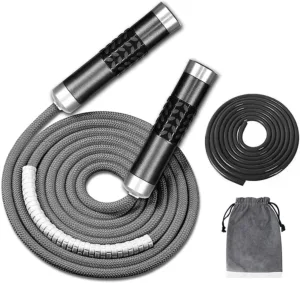Exploring the realm of jump rope techniques unveils a dynamic world of skill and agility. Whether you’re a beginner seeking foundational moves or an advanced practitioner aiming to master intricate tricks, understanding various techniques is key. From basic jumps like the “two-foot” and “alternate foot” to complex maneuvers such as the “crossover” and “double under,” each technique offers a unique challenge. Perfecting these skills not only enhances physical fitness but also sharpens coordination and rhythm. Join us as we delve into the nuances of jump rope techniques, unlocking the secrets to elevate your workout routine and boost your performance.
Jump Rope Basics
Choosing Rope
When starting, beginners should consider the weight of the rope they use. Opt for a slightly weighted rope to improve form and rhythm. Explore various rope options to find the best fit for your needs.
Sizing Guide
To ensure proper sizing, measure the jump rope according to your height. Choose a rope that is adjustable for personalized use. Follow specific guidelines to select the correct length based on your measurements.
Holding Techniques
To master efficient jumping, focus on mastering the proper grip. Enhance performance by paying attention to hand positioning. Practice holding the rope with minimal tension to have better control over your movements.
Proper Form
Maintain symmetry in hand movements while jumping rope. Minimize elbow and shoulder motion to execute proper form. Keep your feet close together during jumps for enhanced stability and balance.
Bounding Fundamentals
Proper Bounding
Jump rope enthusiasts should focus on Speed Control to enhance their workouts effectively. Practicing consistent pace and utilizing wrist movements for adjusting rotation speed are crucial techniques. By mastering these skills, individuals can tailor their workout intensity to match their fitness goals.
When aiming for Height Consistency, it is essential to maintain an even jump height throughout the routine. Landing softly not only reduces impact on joints but also improves overall performance. By concentrating on a steady rhythm, jumpers can ensure a fluid and efficient workout session.
Basic Footwork Skills
First Exercise
Start with basic jump exercises. Focus on proper foot positioning and posture. Begin with simple jumps to build foundational skills.
Basic Techniques

High Knees
Engage core muscles for high knee jumps. Increase intensity by lifting knees higher. Alternate between regular jumps and high knees for a varied workout.
Boxer Step
Practice the boxer step footwork pattern. Focus on alternating foot movements. Incorporate boxer steps to improve coordination and agility.
Advanced Techniques Overview
Double Unders
Master the technique of double unders by rotating the rope quickly twice under your feet in one jump. Increase rope speed to maintain momentum and achieve successful double under jumps. Focus on timing and coordination to ensure efficient execution and avoid tripping.
Side Swings
Learn the side swing footwork pattern by swinging the rope to the side of your body instead of over your head. Focus on maintaining a consistent rhythm while swinging the rope, incorporating side swings into your routine for a dynamic workout.
Travelers
Practice the travelers’ footwork pattern by moving laterally as you jump, challenging your agility and coordination. Incorporate travelers into your routine to enhance agility, improve balance, and add variety to your workout.
Enhancing Coordination
Ski Jumps Tutorial
Master the ski jump technique by mimicking skiing movements. This full-body workout engages core muscles for stability.
Imitate the side-to-side motion of skiing for effective jumps. Ensure proper form to maximize the benefits of this technique.
Engage your core muscles to maintain balance and control during ski jumps. Practice regularly to improve coordination skills.
Mummy Kicks Breakdown
Learn the footwork pattern for mummy kicks. Focus on kicking your legs forward and backward in a controlled manner.
Incorporate mummy kicks into your routine for a challenging workout variation. This technique enhances agility and lower body strength.
Mastering Precision
Scissors Movement
Jump rope enthusiasts can enhance their skills by mastering the scissors movement. This technique involves crossing the legs while jumping, promoting dynamic footwork. By practicing this movement, individuals can improve their coordination and agility.
Engaging in the scissors movement requires a focus on the precise timing of leg crossings during each jump. This technique not only challenges coordination but also adds flair to your jump rope routine. Incorporating the scissors movement into your practice sessions can elevate your overall performance.
One Foot Hops
To advance in jump rope techniques, mastering one-foot hops is essential for achieving balance and control. This technique involves landing softly on one foot while maintaining stability throughout the movement. Alternating between legs during one-foot hops provides a challenging workout that enhances strength and endurance.
Practicing one-foot hops helps individuals develop better proprioception and body awareness. By focusing on landing softly and evenly distributing weight on one foot, jumpers can improve their balance over time. Incorporating one-foot hops into regular training sessions can lead to increased stability and control during jump rope routines.
Building Endurance
Workout Routines
Beginner Workouts
Start with basic jump rope routines to build endurance gradually.
Focus on perfecting your form and rhythm before advancing.
Incorporate short rest periods between sets for optimal recovery.
Advanced Workouts
Challenge yourself with high-intensity jump rope workouts for endurance.
Integrate complex footwork sequences to enhance agility and coordination.
Extend the duration and intensity of your sessions for advanced fitness levels.
Incorporating a variety of jump rope techniques into your workout routine can significantly improve your endurance levels. Starting with beginner-friendly routines allows you to establish a solid foundation in jump rope skills. By focusing on mastering basic techniques such as proper hand positioning and timing, you set yourself up for success as you progress to more advanced workouts.
As you advance in your training, incorporating rest intervals becomes crucial in maintaining endurance levels. These short breaks allow your muscles to recover, reducing fatigue and preventing injury. Varying the intensity of your workouts by alternating between high and low-intensity intervals can further enhance your endurance capacity over time.
Transitioning to advanced jump rope routines introduces new challenges that push your endurance limits. Complex footwork patterns not only engage different muscle groups but also enhance your coordination and agility. By incorporating these dynamic movements into your workouts, you elevate the intensity level, leading to greater cardiovascular benefits and improved stamina.
Safety and Maintenance
Rope Care
To ensure the longevity of your jump rope, maintain its cleanliness by wiping it down after each use. Proper storage is crucial to prevent tangling, so consider using a hook or a designated container. Regularly check for wear and tear on the rope itself, especially near the handles.
Jumping rope with a frayed or damaged rope can be dangerous, leading to accidents during workouts. By keeping your jump rope clean and in good condition, you enhance both safety and performance. Remember that a well-maintained rope lasts longer and provides a smoother jumping experience.
Injury Prevention
Before starting your jump rope session, always warm up to prepare your muscles and joints for the activity. This simple step can significantly reduce the risk of sprains or strains during your workout. Pay attention to your form while jumping to avoid unnecessary stress on your body.
Injuries from jump rope activities are often caused by repetitive movements without proper form. By focusing on maintaining correct posture and technique, you can lower the chances of experiencing discomfort or pain. Listen to your body’s signals and avoid pushing yourself too hard, as overtraining can lead to injuries.
Final Remarks
The comprehensive exploration of jump rope techniques in this blog post has provided valuable insights into mastering this dynamic form of exercise. From the fundamental basics to advanced precision, each section has equipped readers with the knowledge needed to enhance their skills and build endurance effectively. Safety tips and maintenance guidelines underscore the importance of a holistic approach to jump rope training.
To excel in jump rope techniques, consistent practice, attention to detail, and a focus on form are crucial. By incorporating the strategies outlined in this article, individuals can elevate their jump rope skills and experience the numerous benefits it offers. Whether aiming for improved fitness levels or seeking a fun and challenging workout routine, mastering jump rope techniques can lead to a healthier and more active lifestyle.
Frequently Asked Questions
What are the key components of jump rope techniques?
Jump rope techniques encompass various elements such as footwork, coordination, precision, endurance, and safety measures. Mastering these components is crucial for effective and safe jump rope routines.
How can beginners improve their jump rope skills?
Beginners should start with mastering basic footwork skills before progressing to more advanced techniques. Consistent practice, focusing on form and rhythm, and gradually increasing intensity can help improve jump rope skills efficiently.
Are there specific safety tips to keep in mind while practicing jump rope techniques?
Safety is paramount when practicing jump rope techniques. Ensure you have adequate space, use a proper surface, wear supportive footwear, maintain good posture, start with warm-up exercises, and avoid overexertion to prevent injuries during your training sessions.
What is the significance of coordination in jump rope techniques?
Coordination plays a vital role in executing jump rope techniques effectively. It involves syncing hand movements with footwork, maintaining a consistent pace, and timing jumps accurately. Developing coordination enhances overall performance and enables smoother transitions between different moves.
How can one enhance precision when performing jump rope techniques?
To enhance precision in jump rope techniques, focus on maintaining a steady rhythm, keeping the ropes taut but not too tight, controlling your jumps’ height, and ensuring proper hand positioning. Practicing specific drills that target accuracy and timing can also help refine your precision.
